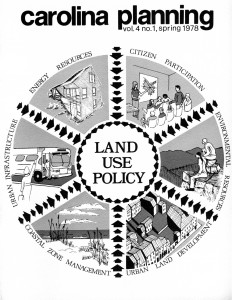 Volume 4.1 Land Use Policy (1978)
Volume 4.1 Land Use Policy (1978)
A major characteristic of planning practice in this nation has been an ever widening sphere of interest and action. From an early focus on the physical development of our cities, planning has evolved a more general concern that encompasses the range of public policy programs. This has occurred both because of the interconnected nature of government programs and because of changing societal definitions of the responsibilities and acceptable actions of government. With the widening sphere of planning, however, coordination among planning efforts has become increasingly difficult.
Editors: Bruce Stiftel, Ann Silverman, Norman Axler, Michael Redmond
A digital version of this issue is available here.
| Urban Land Use Policy in an Era of Constraints
F. Stuart Chapin Jr. The role of the urban planner is changing rapidly due to demands on localities made by disparate federal & state programs that increase complexities and decrease local control. The author identifies points of greatest tension and makes predictions for the future. |
| Growth Management for Barrier Island Communities: A Comparative Evaluation
Glenn Harbeck The attempts of two southeastern communities to control growth in rapid development period are examined. Harbeck contrasts and evaluates programs in Wrightsville Beach, North Carolina and Sanibel, Florida. Growth management can only be as good as state enabling legislation and coastal management programs that guide their formulation. |
| Rural Land Use Mapping by Satellite: A Case Study of Region D COG, North Carolina
Benjamin Orsbon and Richard Reiman Satellite imagery can be used to help construct an existing land use map in rural areas. This case study of the use of LANDSAT data in a mountain region of North Carolina illustrates the economies, advantages, and disadvantages of its use. Rural contexts are also described. |
| Measuring Public Values in Environmental Assessment
Bruce Clary Determining citizen opinion of plan alternatives is often complicated because citizens do not fully understand the alternatives. Clary presents a technique that relies on environmental valuation and the effects of various alternative plans. The techniques is applied to the Raleigh-Durham airport controversy. |
| Determining Community Attitudes and Preferences for Programs & Services
Bonnie Nardi and Joe Harding A survey method for obtaining citizen input is presented. In this two stage process, called Heuristic Elicitation, community needs, interests, and problems are determined through interviews and then quantified through questionnaires. Applications to health planning in North Carolina and community facility design in New Mexico are described. |
| Solid Waste as a Supplemental Fuel for Power Plants in North Carolina
Norman Axler Solid waste is potentially a supplemental fuel for coal burning plants. The author discusses technology in the conversion of conventional power plants, supply levels needed to make it economically feasible, and previous experiences in other areas. Identifies suitable North Carolina facilities. |